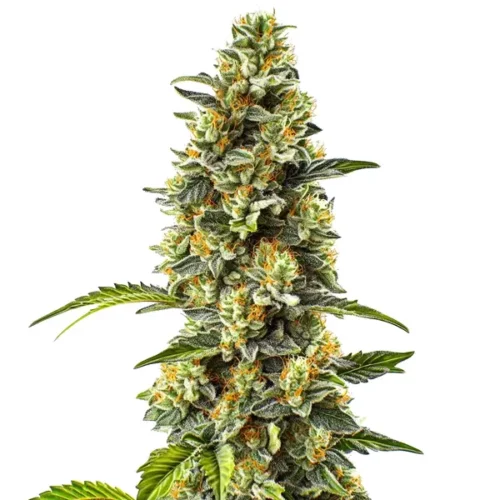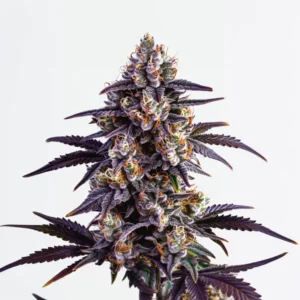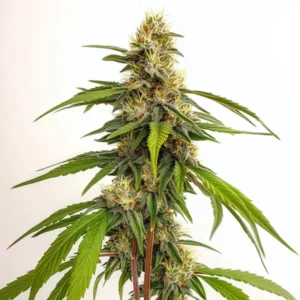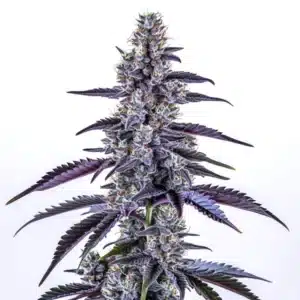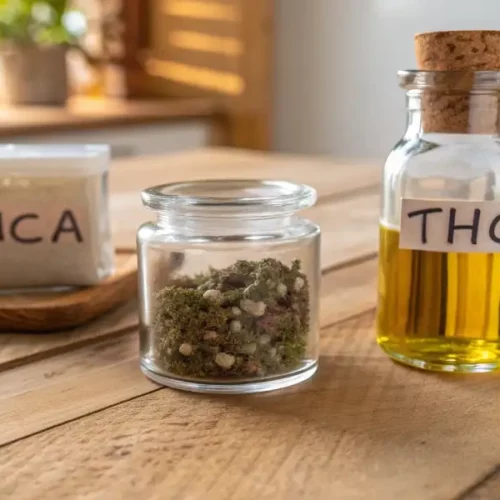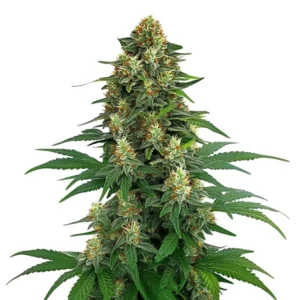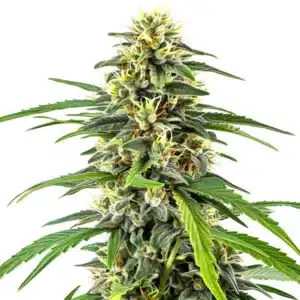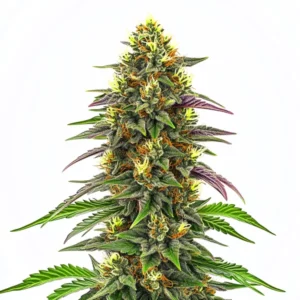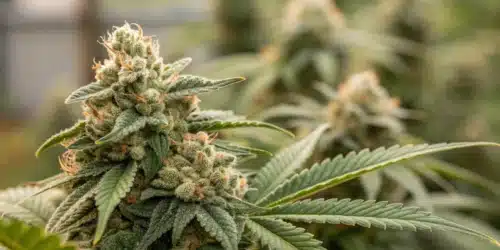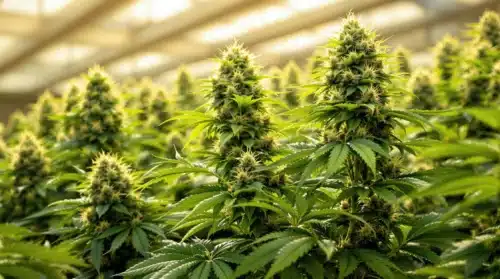Strawberry Cough Seeds Description
Strawberry Cough Strain is a highly esteemed cannabis strain, celebrated for its distinct strawberry aroma and potent effects. This strawberry cough weed is particularly popular for its uplifting effects and unique taste, making it a favorite among enthusiasts of marijuana. Renowned among both recreational and medicinal users, this strain offers a unique experience with its blend of flavors and robust performance.
This strain is a cross between Strawberry Fields and Haze, creating a sativa-dominant hybrid with remarkable qualities. Wondering what strain is Strawberry Cough? It’s a legendary sativa hybrid that stands out in the cannabis world. The buds of this strain are medium to large, often displaying a vivid green color with hints of purple. The buds are dense and covered in a generous layer of trichomes, giving them a frosty and appealing appearance.
Recommended Strains
Strawberry Cough
 THC: 19% - 23%
THC: 19% - 23% Type of seed: Feminized
Type of seed: Feminized Phenotype: Mostly Sativa
Phenotype: Mostly Sativa Day to flower: 8 - 10 weeks
Day to flower: 8 - 10 weeks
One of the standout features of the Strawberry Cough strain is its exceptional aroma and flavor profile, solidifying its place among the most sought-after strawberry cough strains. It exudes a sweet, berry-like fragrance with strong hints of fresh strawberries. The taste is equally delightful, with a smooth, fruity inhale and a subtle hint of spice on the exhale, creating a memorable smoking experience.
Promos & Deals
Strawberry Cough Strain Grow Info
Creating the optimal environment for your Strawberry Cough plants is crucial for their growth and yield. The specific needs of this strain will help ensure a successful cultivation process.
Strawberry Cough seeds thrive in a temperate climate, with daytime temperatures ranging between 70-80°F (21-27°C). This environment ensures the best results for cultivating Strawberry Cough weed. Maintaining a stable temperature and humidity level is essential to prevent stress and potential issues such as mold or mildew.
When cultivating this strain indoors, providing adequate lighting is key. High-quality LED grow lights or HPS lamps are recommended to ensure proper photosynthesis and robust bud development. During the vegetative phase, maintain a light cycle of 18–20 hours of light per day, and switch to 12 hours of light and 12 hours of uninterrupted darkness to initiate flowering. Documenting these steps in a Strawberry Cough grow diary can help track progress and optimize future grows.
For outdoor cultivation, choose a location with ample sunlight and a favorable climate. The strain flourishes in a sunny and warm environment, enabling it to reach its full potential. In regions with cooler climates, consider using a greenhouse or providing additional protection to extend the growing season and safeguard your plants from adverse weather conditions. This approach helps ensure that your plants reach their optimal Strawberry Cough flowering time.
Setting Up The Growing Cannabis Space
Before you begin growing Strawberry Cough seeds, it is essential to establish an efficient and well-organized growing space to maximize the potential of your marijuana plants. Whether you choose to cultivate indoors or outdoors, consider the following factors:
Indoor Cannabis Cultivation
For indoor growers, selecting the right grow tent or dedicated grow room is crucial. Ensure the space provides sufficient room for the plants to grow vertically and has proper ventilation to maintain a fresh airflow. Install an efficient exhaust system with a carbon filter to control odors and prevent the accumulation of heat or humidity. Use reflective materials or Mylar sheets to maximize light distribution and avoid light leaks that could disrupt the flowering phase.
Choose a suitable growing medium for this strain, such as high-quality soil or a hydroponic system, depending on your preferences and experience. Ensure proper drainage to prevent waterlogging and maintain a balanced pH level of around 6.0-6.5 for optimal nutrient absorption.
Outdoor Cannabis Cultivation
When cultivating Strawberry Cough seeds outdoors, select a location with plenty of sunlight and suitable soil conditions. Ensure the soil is well-draining and rich in organic matter. Consider using large containers or fabric pots to have better control over soil quality and root health. Additionally, protect your plants from strong winds by placing them near a fence or using windbreaks.
Using stakes or trellises to support the branches of your plants is recommended. This helps prevent the branches from bending or breaking under the weight of the dense buds and promotes better airflow.

Propagation and Germination of Strawberry Cough Seeds
Successful germination and propagation are essential for healthy and vigorous plants. Follow these steps to ensure a high germination rate and successful propagation:
1. Start by selecting high-quality Strawberry Cough seeds from a reputable seed bank. This ensures genetic stability and the feminization of your plants.
2. Begin the germination process by soaking the seeds in distilled water or a damp paper towel for 24-48 hours. Maintain a temperature between 70-85°F (21-29°C) and provide a dark and undisturbed environment.
3. After the seeds have soaked and developed taproots, transfer them carefully to a pre-moistened growing medium, such as a seedling tray or small pots filled with a light and well-draining soil mix.
4. Place the seeds in a warm and humid environment with gentle airflow. Maintain a temperature around 75-80°F (24-27°C) and a humidity level of 60-70% for optimal germination.
5. Provide indirect light to the seedlings during the first few days, gradually increasing the light intensity as they develop. Avoid exposing them to intense light or heat that could cause stress or damage.
6. Once the seedlings have developed a few sets of true leaves, they are ready to be transplanted into larger pots or the final growing containers.
By following these germination and propagation steps, you can ensure a successful start for your plants and establish a strong foundation for healthy growth and abundant yields.
Vegetative Phase of Strawberry Cough
The vegetative phase is a crucial stage in the development of your Strawberry Cough plants. Here are some key considerations during this phase:
Lighting: Provide your plants with 18-20 hours of light per day to promote vigorous vegetative growth. High-quality LED grow lights or HPS lamps are recommended to ensure sufficient light intensity and spectral distribution.
Nutrition: During the vegetative phase, your plants require a balanced and nutrient-rich diet. Use a reputable cannabis fertilizer with a higher nitrogen (N) content to encourage healthy leaf and stem growth. Follow the manufacturer’s instructions and monitor the plants for any signs of nutrient deficiencies or excesses.
Watering: Water your plants when the top inch of the soil feels dry. Avoid overwatering, as it can lead to root rot and other moisture-related issues. Allow the soil to dry out slightly between watering sessions, but ensure the plants do not experience extreme drought.
Training: Consider employing training techniques such as low-stress training (LST) or topping to control the height and shape of your plants. These methods help create an even canopy, increase light penetration, and promote better bud development.
Pruning: Remove any lower branches or leaves that receive little light or show signs of disease or pests. This helps improve airflow and reduces the risk of mold or mildew formation.
By providing your plants with the right environmental conditions, nutrition, and care during the vegetative phase, you can establish healthy and robust plants ready to produce premium Strawberry Cough buds.
Strawberry Cough Strain Flowering Time
The Strawberry Cough Strain flowering time is the most anticipated stage of growing Strawberry Cough seeds, as it determines the quality of your bud. Here’s what you need to know:
Lighting: Adjust the light cycle to 12 hours of light and 12 hours of uninterrupted darkness to initiate the flowering phase. Use a timer to maintain a consistent light schedule. During this stage, your plants require intense light, so ensure your grow lights provide adequate coverage and maintain the appropriate distance from the canopy.
Nutrition: Transition from a nutrient formula higher in nitrogen to a bloom or flowering-specific nutrient formula. These formulations are generally higher in phosphorus (P) and potassium (K), which promote bud development and overall flowering performance. Monitor the plants closely and adjust nutrient levels as needed to avoid deficiencies or toxicities.
Temperature and Humidity: Maintain a slightly lower temperature during the flowering phase, ideally around 65-75°F (18-24°C), to encourage resin production and prevent heat-related stress. As for humidity, aim for levels around 40-50% to minimize the risk of mold or bud rot.
Support: As your plants enter the flowering phase, the weight of the developing buds may cause branches to bend or break. Provide adequate support using stakes or trellises to ensure the plants can bear the weight and avoid bud damage.
Flowering Time: Strawberry Cough seeds typically has a flowering time of 9-10 weeks, but this can vary depending on the specific phenotype and environmental conditions. Monitor the trichome development using a magnifying tool to determine the optimal harvest window.
Throughout the flowering phase, maintain a vigilant eye for any signs of pests or diseases. Implement proper pest management practices and take immediate action at the first sight of infestation or abnormalities.
Cannabis Fertilization and Nutrition
Proper nutrition and fertilization are crucial for maximizing the growth, yield, and overall health of your plants. Consider the following tips:
Choosing the Right Fertilizer: Select a high-quality cannabis-specific fertilizer or nutrient line that provides a balanced blend of macro and micronutrients. Look for products rich in nitrogen (N), phosphorus (P), and potassium (K) to support healthy growth, root development, and bud formation.
Feeding Schedule: Follow the manufacturer’s instructions and adjust the feeding schedule based on your plants’ specific needs. Start with a lower concentration and gradually increase it as the plants progress through their growth stages. Monitor the plants closely for any signs of nutrient deficiencies or excesses, and make adjustments accordingly.
Supplements and Additives: Consider incorporating supplements and additives into your feeding regimen to enhance specific aspects of plant development. These may include bloom boosters, beneficial microbes, enzymes, or organic amendments that improve soil structure and nutrient availability.
When managing your Strawberry Cough outdoor grow, regularly monitor your plants’ response to the feeding program, adjusting nutrient concentrations and frequencies as needed. Remember to flush the plants with pure water during the final weeks of the flowering phase to remove any excess salts or nutrients, which can affect the flavor and overall quality of the final harvest.
Pest And Disease Control for Cannabis Growing
While Strawberry Cough seeds are known for its resilience, it is still susceptible to pests and diseases. Implementing proper pest and disease control measures is crucial to protect your plants and ensure a successful cultivation. Here are some preventive and corrective actions:
Prevention:
- Regularly inspect your plants for any signs of pests, such as spider mites, aphids, or thrips. Early detection is key to preventing a full-blown infestation.
- Maintain a clean and tidy growing space, removing any dead plant material or debris that could harbor pests or pathogens.
- Introduce beneficial insects, such as ladybugs or predatory mites, to your garden to help control pests naturally.
- Ensure proper airflow and ventilation in the growing space to reduce the risk of mold or mildew formation.
- Quarantine new plants or clones before introducing them into your growing area to prevent the spread of pests or diseases.
Corrective Actions:
- If you detect pests, use organic or low-toxicity pest control products specifically formulated for cannabis. Follow the instructions carefully and avoid using harsh chemicals that can compromise the quality of your harvest.
- For common fungal diseases like powdery mildew or botrytis, remove infected plant material, increase airflow, and consider using organic fungicides or natural remedies such as neem oil or a milk spray solution.
- When dealing with severe infestations or persistent diseases, consult with a professional grower or horticulturist for tailored advice and appropriate solutions.
Harvesting and Curing for Cannabis Growing
Harvesting your Strawberry Cough at the right time and properly curing the buds are crucial steps to preserve their aroma, flavor, and potency. Follow these guidelines:
Trichome Maturity: Use a magnifying tool to examine the trichomes on the buds. Wait until they have reached their desired maturity, indicated by a milky or cloudy appearance with some amber trichomes. This ensures the optimal balance of cannabinoids and terpenes.
Harvesting: Use clean, sterilized pruning shears or scissors to cut the branches one by one. Be careful not to damage the buds during the process. Remove any large fan leaves, but leave smaller sugar leaves intact, as they contribute to the final bud structure.
Drying: Hang the harvested branches upside down in a dark, well-ventilated area with a temperature around 60-70°F (15-21°C) and humidity levels around 50-60%. Ensure proper airflow and avoid overcrowding the drying space to prevent mold or mildew formation. The drying process typically takes 7-14 days, depending on the environmental conditions.
Curing: After the branches have dried, carefully remove the buds from the stems and place them in airtight glass jars. Store the jars in a cool, dark place with a temperature of around 60-70°F (15-21°C) and a humidity level of 58-62%. Open the jars daily for the first week to allow excess moisture to escape, gradually reducing the frequency to once every few days. Curing typically takes 2-4 weeks or longer for optimal flavor and potency development.
Proper harvesting and curing techniques contribute significantly to the overall quality of your Strawberry Cough buds. Take your time, be patient, and enjoy the rewarding process of transforming your harvest into a premium product.
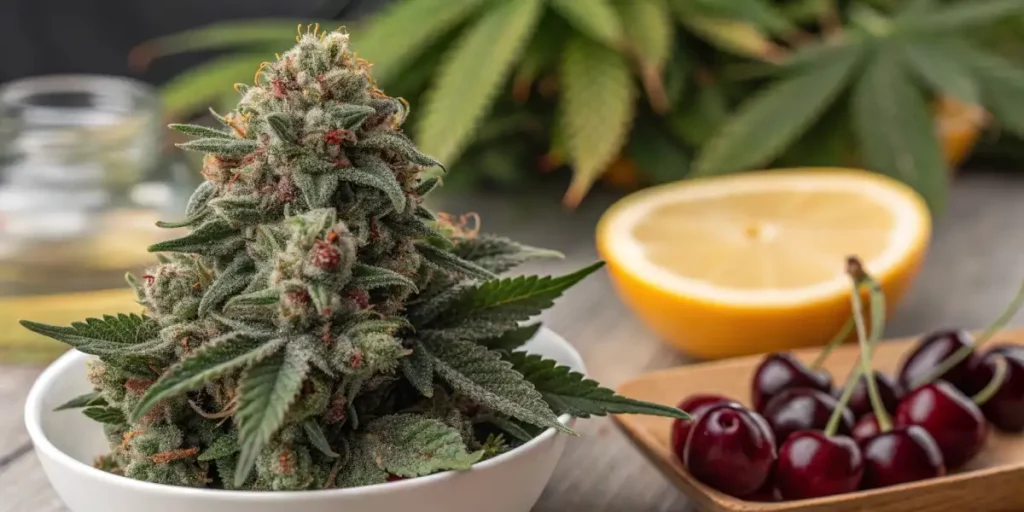
Is Strawberry Cough Strain Indica or Sativa?
The strain is a sativa-dominant hybrid cannabis strain, delivering effects that make it a favorite among those searching for strawberry cough marijuana or wondering, “Is Strawberry Cough Strain indica or sativa?” The exact sativa to indica ratio can vary depending on the specific phenotype or breeder’s selection, but it is generally considered to have a significant sativa dominance.
This strain delivers a cerebral high typical of sativa strains, solidifying its reputation among the best strawberry cough strains, providing users with a boost of energy, creativity, and focus. Despite its sativa dominance, this strain also offers a subtle body relaxation, making it suitable for daytime use without causing excessive sedation.
Whether you’re seeking an invigorating experience to enhance creativity and productivity or a mild relaxation to ease stress and anxiety, this strain offers a well-rounded effect that caters to a wide range of preferences.
Advantages of Growing Strawberry Cough Seeds
Growing Strawberry Cough offers several advantages that make it an attractive choice for cannabis cultivators looking to produce high-quality this marijuana:
- High-quality buds with a unique strawberry aroma and flavor profile.
- Sativa-dominant effects suitable for daytime use.
- Resilient and vigorous growth.
- Wide availability of feminized seeds.
- Adaptable to different growing environments (indoors and outdoors).
- Relatively short flowering time compared to other sativa strains.
- Good resistance to pests and diseases.
Disadvantages of Growing Strawberry Strain Cannabis Seeds
- Potential for high odor during flowering, requiring proper odor control measures.
- Requires precise monitoring of nutrient levels to prevent nutrient burn.
- May require additional support for branches due to heavy bud development.
- Some phenotypes may have lower yields compared to other strains.
Despite these potential challenges, many growers find that the advantages and unique qualities of the strain outweigh any potential drawbacks.
Why Buy Strawberry Cough Seeds
There are several reasons why you should consider buying Strawberry Cough seeds:
1. Unique Aroma and Flavor: This strain offers a delightful combination of sweet, berry-like flavors, making it a highly enjoyable smoking or vaping experience.
2. Versatile Effects: The sativa-dominant effects of Strawberry Cough provide an uplifting and energizing experience, making it suitable for both recreational and medicinal users.
3. Medicinal Benefits: This strain has gained recognition for its potential medicinal benefits, including stress reduction, anxiety relief, and mood enhancement.
4. Cultivation Potential: Whether you’re a beginner or an experienced grower, Strawberry Cough seeds offers a rewarding cultivation experience. It adapts well to different growing environments and produces high-quality buds.
5. Popularity and Availability: This strain has established a strong reputation in the cannabis community and is readily available from reputable seed banks and dispensaries.
When purchasing this strain, ensure you buy from trusted sources to guarantee the authenticity and quality of the genetics.
Problems in Cultivating Strawberry Cough Strain
While this strain is generally robust and resilient, growers may encounter some common problems during cultivation. Here are a few issues to be aware of:
1. Nutrient Deficiencies or Excesses: Incorrect nutrient levels or imbalances can lead to nutrient deficiencies or toxicities. Monitor your plants closely and adjust the feeding regimen as needed to maintain a healthy nutrient uptake.
2. Pests and Diseases: Although Strawberry Cough seeds have good resistance to pests and diseases, it is not entirely immune. Implement preventive measures, regularly inspect your plants, and take immediate action if any issues arise.
3. Odor Control: During the flowering phase, this strain can produce a strong and distinctive odor. Install carbon filters or other odor control methods to prevent the smell from becoming a nuisance.
4. Environmental Factors: High temperatures, humidity fluctuations, or inadequate airflow can stress your plants and lead to various problems such as heat stress, mold, or bud rot. Maintain a stable and suitable environment throughout the entire growth cycle.
By being proactive, closely monitoring your plants, and promptly addressing any problems, you can minimize the impact of these issues and maximize the success of your Strawberry Cough seeds cultivation.
Remember, growing Strawberry Cough requires patience, attention to detail, and a passion for producing top-quality cannabis. With the right care and cultivation techniques, you can enjoy a bountiful harvest of this highly acclaimed strain.
FAQs Strawberry Cough Strain Grow Info
What are the main effects of Strawberry Cough Strain?
This strain is known for its uplifting and energizing effects, making it a standout among strawberry cough weed options, providing users with a boost of creativity and focus. It also offers a subtle relaxation, making it suitable for daytime use without causing excessive sedation.
How long does Strawberry Cough take to flower?
Strawberry Cough seeds typically has a flowering time of 9-10 weeks, but this can vary depending on the specific phenotype and environmental conditions. Monitoring trichome development can help determine the optimal harvest window.
Is Strawberry Cough Strain difficult to grow?
Strawberry Cough seeds are considered relatively easy to grow, making it suitable for both beginners and experienced cultivators. It is resilient and adapts well to different growing environments, although it requires careful monitoring of nutrient levels and proper pest control.
What are the flavor and aroma profiles of Strawberry Cough?
This strain is renowned for its sweet, berry-like aroma and flavor, with strong hints of fresh strawberries. The taste is smooth and fruity, with a subtle hint of spice on the exhale.
What are the medicinal benefits of Strawberry Cough?
This strain has gained recognition for its potential medicinal benefits, including stress reduction, anxiety relief, and mood enhancement. Its uplifting effects can help alleviate symptoms of depression and fatigue.

